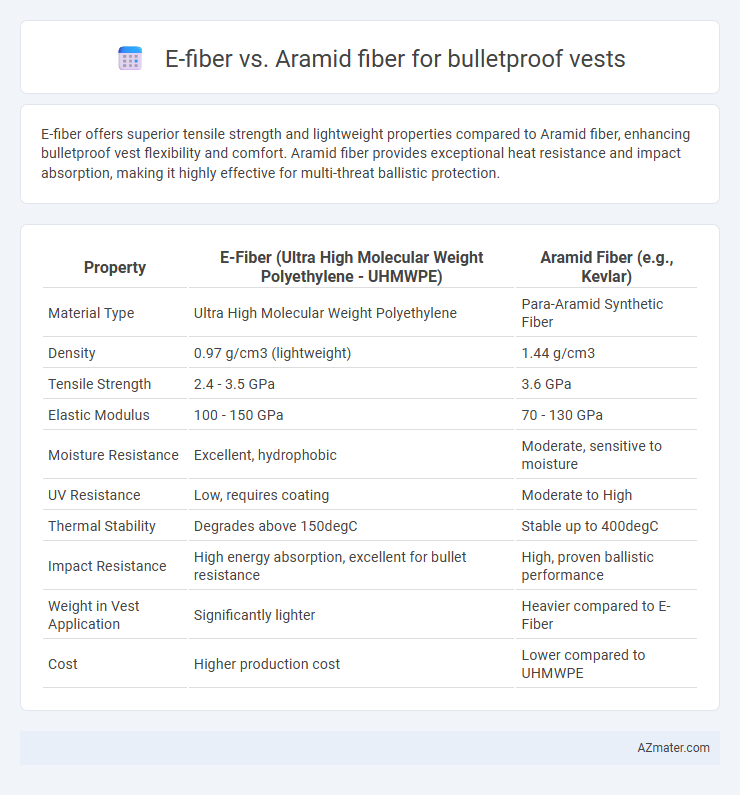E-fiber offers superior tensile strength and lightweight properties compared to Aramid fiber, enhancing bulletproof vest flexibility and comfort. Aramid fiber provides exceptional heat resistance and impact absorption, making it highly effective for multi-threat ballistic protection.
Table of Comparison
| Property | E-Fiber (Ultra High Molecular Weight Polyethylene - UHMWPE) | Aramid Fiber (e.g., Kevlar) |
|---|---|---|
| Material Type | Ultra High Molecular Weight Polyethylene | Para-Aramid Synthetic Fiber |
| Density | 0.97 g/cm3 (lightweight) | 1.44 g/cm3 |
| Tensile Strength | 2.4 - 3.5 GPa | 3.6 GPa |
| Elastic Modulus | 100 - 150 GPa | 70 - 130 GPa |
| Moisture Resistance | Excellent, hydrophobic | Moderate, sensitive to moisture |
| UV Resistance | Low, requires coating | Moderate to High |
| Thermal Stability | Degrades above 150degC | Stable up to 400degC |
| Impact Resistance | High energy absorption, excellent for bullet resistance | High, proven ballistic performance |
| Weight in Vest Application | Significantly lighter | Heavier compared to E-Fiber |
| Cost | Higher production cost | Lower compared to UHMWPE |
Introduction to Ballistic Fibers
E-fiber and aramid fiber are two primary ballistic fibers used in bulletproof vests, each offering unique protective properties. Aramid fibers, such as Kevlar, are renowned for their high tensile strength, heat resistance, and ability to absorb and disperse projectile energy effectively. E-fibers, composed of glass fibers with extraordinary impact resistance, provide a lightweight and durable alternative but generally have lower flexibility compared to aramid fibers.
Key Properties of E-fiber and Aramid Fiber
E-fiber offers high tensile strength and excellent flexibility, making it lightweight and comfortable for bulletproof vests, while providing effective ballistic resistance. Aramid fiber features superior heat resistance, exceptional impact absorption, and maintains structural integrity under high stress, contributing to enhanced protection levels. Both fibers are crucial in ballistic applications, with E-fiber excelling in comfort and flexibility, and Aramid fiber prioritizing durability and thermal stability.
Comparative Strength and Durability
E-fiber, known for its high tensile strength and lightweight properties, offers excellent impact resistance but tends to degrade faster under UV exposure compared to Aramid fiber. Aramid fiber, such as Kevlar, provides superior durability with remarkable resistance to heat, abrasion, and chemical damage, maintaining structural integrity over prolonged use. The comparative strength of Aramid fiber surpasses E-fiber in multi-hit scenarios, making it the preferred choice for bulletproof vests requiring long-lasting protection.
Weight and Flexibility Considerations
E-fiber offers significantly lighter weight compared to Aramid fiber, enhancing overall comfort and reducing fatigue during prolonged wear in bulletproof vests. Aramid fiber, such as Kevlar, provides superior flexibility and higher tensile strength, allowing better mobility without compromising ballistic protection. When prioritizing weight, E-fiber excels, but for optimal flexibility and durability under impact, Aramid remains the preferred choice in protective gear design.
Ballistic Protection Performance
E-fiber offers lightweight characteristics but generally delivers lower ballistic protection performance compared to aramid fiber, which is renowned for its high tensile strength and excellent energy absorption capabilities. Aramid fibers such as Kevlar provide superior resistance against high-velocity projectiles and multi-hit scenarios, making them the preferred material in bulletproof vests. The inherent molecular structure of aramid fiber enables it to dissipate impact energy more effectively than E-fiber, thereby enhancing overall ballistic protection.
Comfort and Wearability in Vests
E-fiber offers superior lightweight properties compared to Aramid fiber, significantly enhancing comfort and wearability in bulletproof vests by reducing overall garment weight. Aramid fiber, known for its high tensile strength and durability, provides excellent ballistic protection but can be bulkier and less flexible, potentially limiting mobility during extended wear. Advanced E-fiber technology incorporates breathable and moisture-wicking features, improving ventilation and reducing heat buildup, which contributes to prolonged user comfort in tactical environments.
Environmental and Cost Implications
E-fiber offers a more environmentally friendly option for bulletproof vests due to its biodegradability and lower carbon footprint compared to Aramid fiber, which relies on petroleum-based production processes. Cost-wise, E-fiber tends to be less expensive to produce and process, reducing overall manufacturing expenses, whereas Aramid fiber remains pricier due to complex synthesis and higher raw material costs. The choice between E-fiber and Aramid fiber significantly impacts both sustainability goals and budget considerations in ballistic vest production.
Resistance to Heat, Chemicals, and Moisture
E-fiber exhibits superior resistance to heat, maintaining structural integrity at temperatures up to 350degC, whereas Aramid fiber typically degrades above 220degC. Chemically, E-fiber demonstrates enhanced stability against acids and bases, while Aramid fibers are more susceptible to damage from strong oxidizing agents. Moisture absorption is minimal in E-fiber, reducing weight gain and preserving ballistic performance, compared to Aramid fibers, which can absorb up to 7% moisture, potentially compromising durability.
Longevity and Maintenance Requirements
E-fiber bulletproof vests offer superior longevity due to their enhanced resistance to UV degradation and moisture absorption, resulting in extended service life compared to Aramid fiber vests. Aramid fibers, while providing excellent initial ballistic protection, require more frequent inspection and careful handling to prevent weakening from exposure to heat and moisture. Maintenance protocols for E-fiber vests are less stringent, allowing for easier cleaning and reduced replacement frequency, making them more cost-effective over time.
Future Trends in Bulletproof Vest Materials
E-fiber offers lightweight properties and excellent tensile strength, positioning it as a significant contender in the future of bulletproof vest materials alongside aramid fiber, which is renowned for superior impact resistance and thermal stability. Advances in nano-engineering and hybrid composite technologies aim to enhance E-fiber and aramid blends to deliver improved flexibility, durability, and multi-threat protection. Research in bio-based E-fibers and environmentally sustainable aramid manufacturing processes is expected to drive innovation, reducing ecological impact while maintaining high-performance standards for next-generation ballistic armor.

Infographic: E-fiber vs Aramid fiber for Bulletproof Vest
 azmater.com
azmater.com